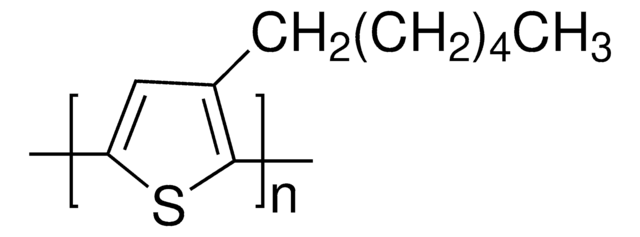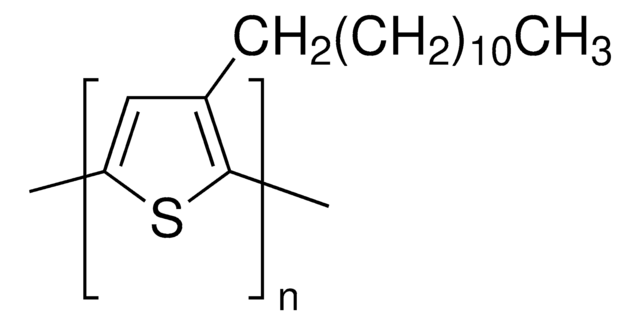推薦產品
材料
black
等級
electronic grade
描述
Band gap: 1.7 eV
化驗
99.995% trace metals basis
形狀
solid
分子量
average Mn ~25,000
mp
198-211 °C
軌道能量
HOMO -5.25 eV
LUMO -3.55 eV
OPV器件效能
ITO/PEDOT:PSS/P3OT:PC61BM (1:2)/LiF/Al
- Short-circuit current density (Jsc): 5.55 mA/cm2
- Open-circuit voltage (Voc): 0.5 V
- Fill Factor (FF): 0.33
- Power Conversion Efficiency (PCE): 0.91 %
半導體屬性
P-type (mobility=10−4 - 10−1 cm2/V·s)
SMILES 字串
[s]1cc(cc1)CCCCCCCC
InChI
1S/C12H20S/c1-2-3-4-5-6-7-8-12-9-10-13-11-12/h9-11H,2-8H2,1H3
InChI 密鑰
WQYWXQCOYRZFAV-UHFFFAOYSA-N
相關類別
一般說明
應用
Rechargeable battery electrodes, electrochromic devices, chemical and optical sensors, light-emitting diodes, microelectrical amplifiers, field-effect transistors and non-linear optical materials.
Used in organic field-effect transistors and in polymer-based solar cells.
特點和優勢
儲存類別代碼
11 - Combustible Solids
水污染物質分類(WGK)
WGK 3
閃點(°F)
Not applicable
閃點(°C)
Not applicable
個人防護裝備
Eyeshields, Gloves, type N95 (US)
客戶也查看了
文章
The application of conducting polymers at the interface with biology is an exciting new trend in organic electronics research.
Organic materials in optoelectronic devices like LEDs and solar cells are of significant academic and commercial interest.
LED 和太陽能電池等光電裝置中的有機材料具有重大的學術和商業價值。
Novel Graphene‑Based Nanostructures Production, Functionalization, and Engineering
Active Filters
我們的科學家團隊在所有研究領域都有豐富的經驗,包括生命科學、材料科學、化學合成、色譜、分析等.
聯絡技術服務

![聚[双(4-苯基)(2,4,6-三甲基苯基)胺] a poly(triaryl amine) semiconductor](/deepweb/assets/sigmaaldrich/product/structures/122/933/c34a34ab-284f-4890-adb8-126247a91d9b/640/c34a34ab-284f-4890-adb8-126247a91d9b.png)







